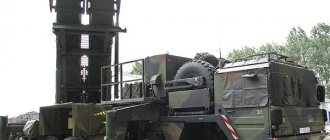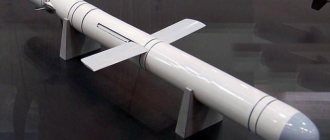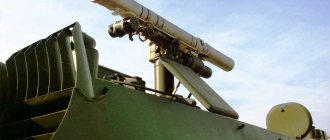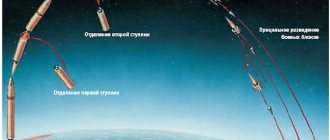Each state is forced to ensure security, respect national interests and maintain global status by strengthening its nuclear shield. The Russian Federation, as one of the strongest players in the international arena, is constantly modernizing its nuclear potential in order to maintain its status as a strategic nuclear state. As a result of the constant struggle with other nuclear powers, the Yars missile system appeared.
The modernization process began in the 90s. last century, but active work began in the mid-2000s. As a result, a new solid-propellant missile RS-24 appeared, which replaces the RS-18 and RS-20A.
How the Yars missile system was created
During the existence of the USSR, a lot of effort and financial resources were invested in the creation and strengthening of the country's nuclear shield. Many systems and components of nuclear weapons were created on the territory of the republics that were previously part of the Union, but later became independent states. This created certain problems during improvement and maintenance.
The weapons were stationary complexes located in launch silos, mobile complexes "Topol-M" and "Topol", liquid fuel "Stilet" and "Voevoda".
As time passed, the weapons became outdated, and the Russian leadership was faced with the task of rearmament of all components of the domestic “nuclear triad.”
In mid-2009, the first sample of the launch unit for the mobile ground RS-24 was created by specialists from the Titan Central Design Bureau. The missiles themselves have been created at the mechanical engineering plant in Votkinsk since 2012.
These complexes are designed to replace the aging intercontinental systems over time, so the Votkinsk plant is completely switching to the creation of the Yars complex.
Ka-52M reconnaissance and attack helicopter
Photo: Konstantin Mikhalchevsky / RIA Novosti
During the international military-technical forum Army 2021, which was held in August, the Ministry of Defense and the Russian Helicopters holding company signed a contract for the supply of modernized Ka-52M helicopters. As part of the agreement, the military will receive 30 reconnaissance and attack vehicles. Later, a source in the aircraft industry said that helicopter deliveries would begin in 2022.
The Ka-52M received a modernized optical-electronic system and a new radar complex with an active phased array antenna (AFAR). Also, the modernized helicopter will be able to carry new weapons, including Ataka, Vikhr and Vikhr-M missiles.
How did the development of the Yars PGRK begin?
As a result of the signing of the START-1 disarmament treaty, the USSR leadership was forced to suspend the development of multiple warheads, reduce the number of nuclear warheads to 1,600 units, and their ammunition to 600 units. In 2009, this agreement expired and the Russian Federation resumed development of a missile with multiple warheads.
On the basis of the aging Topol-M, the Yars PGRK was created with a more advanced control system.
The characteristics are similar to another RK - “Bulava”. The launch method remained the same, but the cost of the complex was greatly reduced. Engineers managed to significantly reduce flight time and increase maneuverability, thereby increasing the degree of invulnerability to enemy missile defense.
Strategic bomber-missile carrier Tu-160M
In 2022, the new Tu-160M strategic bomber-missile carrier will fly
Photo: Photo: Rostec
The basic Tu-160 made its first flight in 1981, and in 2018, the Kazan Aviation Plant began production of modernized, newly built Tu-160M. In December, Deputy Prime Minister Yuri Borisov announced that a new Tu-160M flight was planned for 2022. The aircraft is being built on a new element base.
The Tu-160 remains the largest supersonic aircraft in aviation history. Also, the Tu-160 remains the heaviest combat aircraft and the fastest bomber. The Tu-160 is designed to destroy targets in remote areas with conventional and nuclear weapons.
Work on the creation of ballistic missiles by USSR designers
Development of a solid fuel rocket began back when the mighty union of fifteen republics existed in the 80s. Moscow specialists from the Thermal Engineering Institute and designers from the Dnepropetrovsk Yuzhnoye Design Bureau worked on the creation of a new generation design.
The result of the development was the RT-2PM2 "Topol-M", which was equipped with a monoblock warhead. At the same time, a separately guided missile with a multiple warhead was created. This work became the basis for the Yars ballistic complex that appeared later.
Loitering ammunition KUB-BLA
Loitering ammunition KUB-BLA
Personnel: JSC Concern Kalashnikov
In 2022, the Russian military will receive a new type of weapon. On December 17, the press service of the ZALA Aero company (part of the group) announced the successful completion of state tests of the KUB-BLA drone. The device was recommended for adoption, and deliveries could begin in 2022.
KUB-UAV received an electric motor, which provides a maximum speed of up to 130 kilometers per hour. The ammunition can stay in the air for up to 30 minutes, and the mass of the warhead is 3 kilograms.
Missile tests of RS-24 "Yars"
In mid-2007, the military carried out a test launch of the RS-24 at the Plesetsk test site, and at the end of the same year they carried out repeated tests. All two launches of the RS-24 were successful. The third launch was made in 2008 and was also successful.
All test launches were carried out using Topol-M missiles, since their main indicators are largely similar to each other.
The expert community was very surprised by the small number of trial test launches preceding the transfer of missiles for deployment to a combat post. But the developers assured the concerned community that Yars had been tested using a special program using the latest computer technology.
The software components of this development make it possible to simulate the occurrence of probable situations and reduce the number of actual missile launches. Since nuclear testing was banned in 1989, RS-24 thermonuclear charges were not tested during the development process.
Various information was received from several sources about the completion of design work and testing of the missile system. Thus, the media reported that specialists completed development in 2010, and leading designers claimed that the complex was completely ready for full-scale production at the end of 2009.
Production has been significantly reduced in cost by linking the parameters and technical characteristics of the Yars to the already mass-produced Topol-M and Bulava.
Fifth generation fighter Su-57
In 2022, troops of the Eastern Military District will receive the first Su-57 fighters
Photo: Anna Zvereva / Flickr
In 2022, the first multirole fighters of the fifth generation Su-57 will be received by the troops of the Eastern Military District (VVO). The commander of the Eastern Military District, Colonel General Alexander Chaiko, announced this during the final board meeting of the Russian Ministry of Defense.
The fifth generation fighter Su-57 is designed to destroy all types of ground, air and surface targets. The aircraft received a radio-absorbing coating and weapon compartments inside the fuselage, which makes the Su-57 stealth. The first production aircraft was handed over to the Russian Aerospace Forces in December 2022.
Main components and design of the RS-24
The RS-24 ICBM is intended for targeted impact on large military and industrial facilities of the intended enemy.
The new development differs significantly from its predecessors in that it has a multiple warhead and a modernized guidance and control system.
The Votkinsk plant directly produces Yars rockets, and the production of launch systems is mastered by Volgograd employees. There is an opinion that Yars has the ability to deliver 3-6 warheads, the charge of each of which reaches 300 kilotons, to the intended impact area.
The solid propellant rocket is classified as “ground-to-surface” and consists of three stages. "Yars" is equipped with an outer casing made of composite material, which is based on aramid fiber. During the active phase of the flight, the rocket is controlled by recessed engine nozzles that rotate through a small angle on a hinge. The unit changes the direction of engine thrust at each stage separately. The flight range of the RS-24 reaches 5,500 kilometers.
The period of active flight was significantly reduced, and an improved complex for overcoming missile defense elements was used. Thus, according to available information, Yars produces decoys that are indistinguishable from combat targets in the electromagnetic spectrum. The warheads themselves are elusive to enemy missile defense systems thanks to a coating that absorbs radar radiation.
Modern fifth-generation missiles are prepared for loading and transportation directly at the factory - manufacturers immediately place them in specially equipped fiberglass transport and launch containers.
Previously, the development of ICBMs included the use of liquid rocket fuel engines. But due to the large amount of time and colossal labor intensity of the refueling process, they decided to abandon this type of fuel and switch to using solid fuel.
The Yars quickly picks up speed and is capable of maneuvering at low altitudes during launch and descent of ICBMs. It is safe to say that the RS-24 Yars is equipped with an inertial control system. The computer complex located on board the rocket constantly analyzes all incoming information and adjusts the flight in accordance with the operational situation.
To improve the quality of navigation, the electronics receive information from GLONASS satellites and, according to unconfirmed reports, use astronomical correction, which significantly increases the accuracy of hitting the target. Also, the electronics of ICBMs have the ability to prevent the effects of a nuclear strike. Known characteristics of the RS-24
Let us give a description of the main technical parameters of the Yars missile system and compare them with the technical characteristics of the Topol M.
| Indicator name | Meaning of "Yars" | The meaning of "Topol M" |
| Rocket markings | RS-24 | RS-12M2 |
| Manufacturer | Votkinsk machine-building city Vologograd | |
| Purpose | Intercontinental ballistic | Strategic intercontinental missile system assigned |
| Number of steps, units | 3 | 3 |
| Step length, m | 8 | 8,04 |
| Head type | Nuclear, with multiple warheads | Nuclear, monoblock |
| Max. missile flight range, m | 11 0000 – 12 000 | 11 0000 |
| Max. starting weight, kg | 46 500-47 200 | 47 100 |
| Warhead charge power, Mt | 0.15, 0.3 | 0,55 |
| Rocket length, m | 21,9-22,5 | 22,7 |
| Step diameter, m | 1,56 — 1,85 | 1,95 |
| KVO, m | 150 | 200 |
| Head mass, t | 1,2-1,3 | 1,2 |
| Shelf life | Over 15 years | Over 15 years |
| Base type | Mine, mobile | Mine, mobile |
But, it should be remembered that some of the technical characteristics of this unique development are still classified and the information given in the table is largely approximate.
Electronics device
The Yars rocket is equipped with an inertial control system. All information is processed by the on-board computer complex. He is also responsible for adjusting the flight taking into account information received from GLONASS navigation satellites. The rocket's electronics are highly resistant to nuclear explosions. High accuracy of hitting the target is ensured by the navigation system equipped with the Yars missile. The characteristics of the RS-24 allow it to deliver warheads (up to six pieces) to the affected area. The power of each unit is at least 300 kilotons.
How a rocket launches
According to the designers, the Yars is equipped with a complex for disengaging ballistic combat units. To directly launch a rocket, both mobile and silo-based, a powder pressure accumulator is used. The gases formed during the combustion of the charge eject the rocket from the launch barrel to a small height. Then the main engine starts and controlled flight begins.
Starting is done remotely. Through cables and secret radio channels, an order is received from the command post to launch the rocket, and the electronics of the Yars complex itself are activated.
Secrets from the newspaper
And the Topol-M, the newspaper reported, is a monoblock three-stage strategic silo-based solid-propellant missile. It is classified with the letter “A”, which means it is permanently located in the transport and launch container. This container guarantees that the missile is ready for combat use without factory maintenance for at least 15 years. The previous one is only ten.
The length of the “Topol-M” together with the head part is 22.7 m (for the “Topol” it is 21.5 m). The case diameter is 1.95 m (Topol has 1.80 m). Starting weight - 47.2 tons ("Topol" - 45.1 tons). Throwing weight - 1200 kg (prototype - 1 t). The launch range is more than 10,000 km. The exact power of the nuclear charge is not known, but based on some signs it can be judged that it is included in the megaton class of nuclear warheads. Let me remind you that Topol has 550 kt.
Deputy Director of the Moscow Institute of Thermal Engineering Lev Solomonov, one of the creators of Topol-M and the elder brother of the general designer of MIT and Topol-M Yuri Solomonov, told me then that the nuclear charge of their “product” is quite effective. Not with excessive power, like the warheads of some other missiles, which, as experts understand, will never be used, since they can destroy half the planet, which, in principle, is suicide. Namely, in order to make a possible aggressor think about whether he should threaten Russia or whether it’s better not to.
The nuclear charge for the RS-2PM2, like all previous ones, was created at the VNIIEF design bureau in Arzamas-16. The chief designer is a student of Academician Yuli Khariton, Academician Georgy Dmitriev. And the combat unit was created by the team of the Moscow Institute of Thermal Engineering, the main developer of the entire Topol-M complex, under the leadership of Academician Boris Lagutin and Corresponding Member of the Russian Academy of Sciences Yuri Solomonov. Due to new aerodynamic, ballistic and structural qualities, this unit has the ability to overcome any missile defense, existing and future, and retains the ability to remain on the calculated trajectory and reach a given target under any conditions and hit the specified object with minimal deviation.
How high these combat qualities can be judged, if only because the firing accuracy of the previous mobile ground system "Topol", or SS-25 Sickle, is two times less than that of the "Topol-M", and the maximum deviation from the center of the target itself of the perfect American strategic missile MX is 350 m, which is also worse than that of the RS-2PM2. In addition, the flight path of the warhead in the final part of the trajectory is impossible to predict.
All the test launches, which, by the way, the Americans observed with their national means of control - only one of them was unsuccessful - demonstrated the unpredictability of the behavior of the warhead at this distance, and therefore the highest degree of survivability. It is also ensured by the ability of the warhead to withstand the damaging factors of a nuclear explosion (shock wave, X-ray, light, gamma and neutron radiation).
Experts told me that the Topol-M can be knocked off its trajectory only when its warhead is hit by another missile. Like a bullet hitting a bullet. And such a result, in their opinion, is practically unattainable.
The readiness time of the complex began to be measured not in tens of minutes, as was the case with liquid-propellant rockets, or in several minutes, as in the previous mobile complex, but in seconds. If the American MX rocket leaves the silo after receiving the “launch” command after 30 seconds, then the Topol-M is a few seconds earlier. The advantage in these moments would seem to be quite insignificant, but behind them is not only the highest degree of combat readiness, but also very important technological and design discoveries and features of the new missile system, which laid the basic foundations for further modernization and improvement of the complex.
Many of these features of the new rocket are related to its first stage engine. It was developed at the Yuzhnoye Design Bureau in Dnepropetrovsk under the leadership of General Designer Stanislav Konyukhov. Then, when Ukraine left the cooperation, he was transferred to MIT. And already in Moscow it was finalized and “introduced” into the new complex. And the Moscow Institute of Thermal Engineering, in addition to developing the ideology of the entire system, also has priority in the use of new composite materials and alloys on the complex, the creation of rotary, as experts say, controlled nozzles and auxiliary engines. Their development was led by Deputy General Designer Yuri Vinnichenko.
Deployment and future plans
The Russian Strategic Missile Forces received Yars pilot systems in 2009, although this event was announced for 2010:
- In 2010, these powerful missiles entered combat duty in the Teykov missile division, based in the Ivanovo region. The unit includes 6 RS-24 units.
- In 2013, the missile formations of Novosibirsk and Kozelsk were rearmed with new intercontinental ballistic missiles.
According to unofficial data, there were about 73 RS-24 units in service in Russian missile formations, of which 63 were mobile, 10 silo-based.
In 2022, specialists from the Votkinsk plant planned to produce about twenty units of Yars complexes for the Russian armed forces.
Since 2015, design specialists have been restoring a railway missile system called Barguzin, which will be equipped with Yars strategic ICBMs. According to the Russian Ministry of Defense, the pride of the Russian Strategic Missile Forces will enter service by 2022.
Moreover, in the next decade it is planned to replace the RS-18 and RS-20 “Satan” in service with the new RS-24 complex. The main strike group of the nuclear shield of the Russian Strategic Missile Forces will be the latest Yars intercontinental ballistic missile systems.
Performance characteristics
- Manufacturer - Votkinsk is classified as an intercontinental ballistic missile (ICBM).
- The rocket has three stages.
- The length of one step is 800 cm.
- The size of the rocket including the warhead is 23 m.
- The APU uses a YaMZ-847 diesel engine with a power of 800 hp. With.
- The length of the RS-24 without the head part is 17 m.
- Turning radius – 18 m.
- The missile is designed for a flight range of up to 12 thousand meters.
- "Yars" is equipped with four warheads.
- The weight of the RS-24 is 47 tons 200 kg.
- The weight of the head part is 1.3 tons.
- The width of the APU is over three meters
- The rocket can be equipped with an autonomous or inertial control system.
- KVO - 150 meters.
- The missile is designed for silo and mobile deployment.
- The warranty period of the RS-24 does not exceed 15 years.
Invitation to the Holy of Holies
At the end of 1994, I, then a military correspondent for the Izvestia newspaper, was invited to the Main Headquarters of the Strategic Missile Forces and was offered to write about the further development, or rather the modernization of the Topol strategic missile system. Now, they told me, it could be located not only on a movable dirt platform, but also in a mine. And it became known as RT-2PM2 “Topol-M”, or SS-27 according to the Western classification.
The day before, the first such missile was launched from the test site in Plesetsk, Arkhangelsk region, towards the Kura missile test site in Kamchatka during factory tests, which came as a surprise to the whole world. Including for the United States, although they were warned about such a launch in advance, as required by the START-1 Treaty. But making a promise does not mean getting married, they remembered the famous Russian proverb in Washington. And who could then believe in the White House and in the Pentagon that in a country that was in a deep economic crisis, with a ruined defense industry, which had lost all business ties with its partners in the republics of the former USSR, they would still be able to make such a completely new rocket.
True, the country’s leadership and the Main Command of the Strategic Missile Forces categorically refused to utter these words “new strategic missile”. According to the START-1 Treaty, none of the countries participating in this agreement had the right to create a new missile - only to modernize the old ones. And even then with certain restrictions. In particular, the throw weight of the “modernized” rocket should not exceed the original by more than 21%.
And in order to emphasize the fact of the “modernization” of the RT-2PM, they invited me to the holy of holies - the main headquarters of the Strategic Missile Forces, provided the necessary information for the material, and explained that the modernized Topol should in the future replace all currently existing liquid-fueled strategic nuclear missiles with individually targeted multiple warheads. Including the mentioned “Voevoda” (“Satan”), RS-22 “Well done” (SS-24 Scalpel, it is solid fuel), RS-16 (SS-17 Spanker), RS-18 (SS-19 Stiletto), created in the seventies and eighties of the last century using components from two hundred enterprises in Russia, Ukraine, Tajikistan and the Baltic states. In the early decades of the 21st century, they told me, these missiles would completely exhaust their technical life and be forced to give way to one universal, both silo-based and mobile-based, monoblock solid-fuel rocket, made exclusively at Russian enterprises and design bureaus.
And in order for my material to be deep and convincing, I was provided with all the information that even then, in my opinion, constituted, if not a state, then a military secret. I, a colonel, have never had such truly sensational information in my hands. Needless to say, a couple of days later my article was ready and presented to the then commander-in-chief of the Strategic Missile Forces, Army General Igor Sergeev. He really liked her. He signed it and allowed it to be published.
A rather heavily abbreviated material, “And yet we make rockets,” appeared in the newspaper on January 20, 1995. The then ultra-liberal leadership of the publication considered it impossible to promote, as some of my bosses said, “the militarization of the country.” And although there was a certain irony in the title, reminiscent of the famous line from Yuri Vizbor’s song “We also make rockets, block the Yenisei, and even in the field of ballet we are ahead of the rest,” we managed to tell the main thing about “Topol-M”. The fact that it fully complies with all the restrictive parameters of the START-1 and START-2 Treaties. And the fact that it was assembled at the Votkinsk Machine-Building Plant, the output of which is monitored around the clock by American inspection, but nevertheless the appearance of the modernized rocket was still a surprise for her. According to a number of parameters, overseas experts noted, this “machine” is five to six years ahead of American rocketry.
Not “Topol” alone
These predictions were not fully justified. To date (presumable information from open sources), out of 532 deployed nuclear weapons carriers (in the Strategic Missile Forces, Navy and Aviation), Russia has 45 RT-2PM Topolyas left in Vypolzovo and near Barnaul, as well as 60 Topolei-M RT-2PM2 mine-based in Tatishchevo, Saratov region and 18 mobile complexes in Teykovo, Ivanovo region. Production of Topol-M, like Topol, has been discontinued at the Votkinsk plant. They were replaced by the RS-24 Yars, or RS-12M2R, with increased accuracy and a multiple warhead with individual guidance. Mine and mobile basing method. Capable of overcoming any missile defense system, whether current or future. Also created at the Moscow Institute of Thermal Engineering under the leadership of Yuri Solomonov.
True, in addition to the solid-fuel strategic missile systems of the Topol family, the country is now creating the Sarmat liquid-propellant silo missile, which will replace the RS-20 Voevoda (SS-18 Satan), and several UR-missile systems still remain on combat duty. 100NUTTKH or RS-18 (SS-19 Stiletto). Late last year, some of these missiles were equipped with the Avangard hypersonic combat glide unit, during testing of which the unit reached a speed of Mach 27. And, naturally, it does not have any barriers in the form of any missile defense system and will not have them for many, many years, reliably ensuring, like the “poplar family,” the deterrence of any potential enemy.










